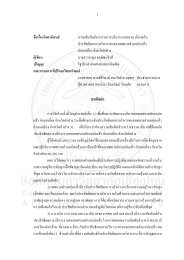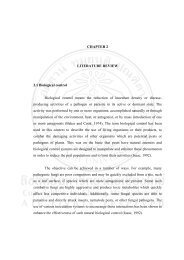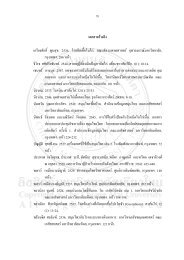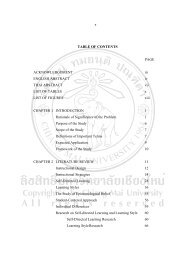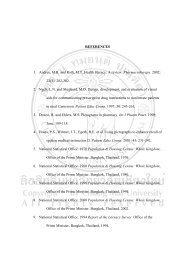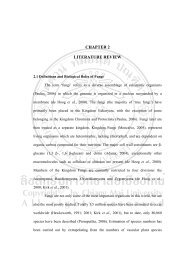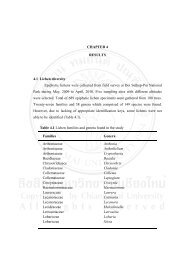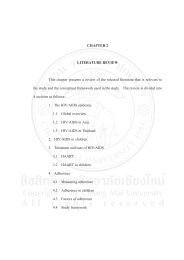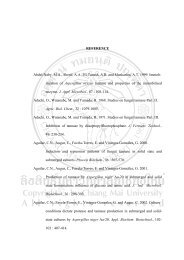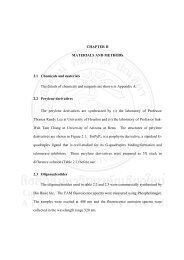prevalence and molecular characteristics of vibrio species in pre ...
prevalence and molecular characteristics of vibrio species in pre ...
prevalence and molecular characteristics of vibrio species in pre ...
You also want an ePaper? Increase the reach of your titles
YUMPU automatically turns print PDFs into web optimized ePapers that Google loves.
9<br />
Pathogenic bacteria associated with seafood can be categorized <strong>in</strong> to three groups<br />
(Feldhusen, 2000). These are<br />
Indigenous bacteria: Normal component <strong>of</strong> the mar<strong>in</strong>e <strong>and</strong> estuar<strong>in</strong>e<br />
environment.<br />
Eg: V. cholerae, V. parahaemolyticus, V. vulnificus, Listeria monocytogenes,<br />
Clostridium botul<strong>in</strong>um, Aeromonas hydrophila (only virulent stra<strong>in</strong>s)<br />
Enteric bacteria: Due to contam<strong>in</strong>ation by the fecal material <strong>of</strong> animals <strong>and</strong><br />
human<br />
Eg: Salmonella spp., pathogenic Escherichia coli, Shigella spp.,<br />
Campylobacter spp., Yers<strong>in</strong>ia enterocolitica (very few pathogenic sero types)<br />
Bacterial contam<strong>in</strong>ation dur<strong>in</strong>g process<strong>in</strong>g: (cross contam<strong>in</strong>ation)<br />
Bacillus cereus (only toxigenic stra<strong>in</strong>s), L. monocytogenes, Staphylococcus<br />
aureus, Clostridium perfr<strong>in</strong>gens.<br />
Although many pathogenic bacteria are associated with the shrimp production<br />
cha<strong>in</strong> only a few organisms (Salmonella, Vibrio <strong>and</strong> Listeria) have been thoroughly<br />
studied for their <strong><strong>pre</strong>valence</strong> <strong>and</strong> public health importance (Wan Norhana et al., 2010).<br />
Bhaskar et al. (1998) found Salmonella <strong>and</strong> Vibrio spp. <strong>in</strong> all the samples <strong>of</strong> shrimp,<br />
sediment, feed <strong>and</strong> pond water dur<strong>in</strong>g the farm<strong>in</strong>g phase <strong>and</strong> at harvest<strong>in</strong>g time.<br />
Listeria spp. was found only <strong>in</strong> clam meat dur<strong>in</strong>g farm<strong>in</strong>g <strong>and</strong> sediment <strong>and</strong> shrimp at<br />
harvest. A study done <strong>in</strong> Sri Lanka revealed the <strong><strong>pre</strong>valence</strong> <strong>of</strong> Salmonella <strong>in</strong> captured<br />
<strong>and</strong> cultured shrimp 14.44% <strong>and</strong> 11.11%, respectively, <strong>and</strong> Salmonella Newport was<br />
the highest (47.83%) among the deferent Salmonella serovars followed by Salmonella<br />
Weltevreden 8.7% (Kamalika et al., 2008). Samples <strong>of</strong> processed <strong>and</strong> unprocessed<br />
shrimp from process<strong>in</strong>g plant <strong>in</strong> Nigeria was analyzed <strong>and</strong> revealed the <strong>pre</strong>sence <strong>of</strong><br />
Bacillus spp., Salmonella spp., Shigella spp., Enterobacter spp., Micrococus spp., E.<br />
coli, Flavobacterium spp., Staphylococus aureus, Pseudomonas spp., Rhizopus spp.,<br />
Aspergillus flavis, Aspergillus formigatus, Mucor mucido, <strong>and</strong> Sacchromyces spp., but<br />
no Vibrio spp. were isolated. This study showed a level <strong>of</strong> contam<strong>in</strong>ation by<br />
pathogenic bacteria that is hazardous for the consumer’s health (Okonko et al., 2008).




